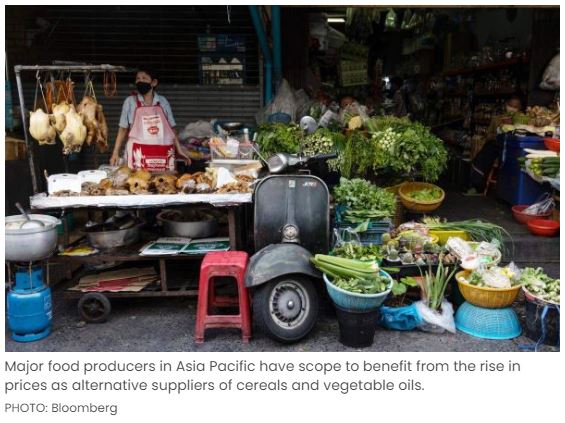Policy response to food shocks to have lasting effects on sovereigns, companies: Moody’s
WHILE Asia Pacific economies have less exposure to commodity-disruption brought about by the Russia-Ukraine military conflict, pockets of the region are highly vulnerable to food inflation, which could heighten social risks and trade protectionism, said Moody’s Investors Service in a note on Jul 19.
In particular, the Philippines, India, Thailand and Vietnam have high energy and food weights in their Consumer Price Index baskets, said Moody’s assistant vice-president and analyst, Deborah Tan.
“Food inflation will elevate social risks across the region, with Bangladesh, Cambodia, Pakistan and Laos having the highest risks,” added Tan.
That being said, major food producers in the region have scope to benefit from the rise in prices as alternative suppliers of cereals and vegetable oils. These include Australia, Indonesia, Thailand and Vietnam. However, the agricultural sectors of these economies will require time to increase production capacity to meet external demand, noted the report.
Separately, the rising risk of trade protectionism will be credit negative for a range of industries. Beyond food importers, exporting sectors in countries imposing restrictions will also be impacted, as logistics demand or port throughput weakens, said the Moody’s team.
According to the report, the number of restrictive food export policies adopted internationally has risen since the onset of the pandemic to 148 policies as of June 2022. The number of countries participating in such policies rose to 58 in June 2022, from 41 a year earlier.
“Tit-for-tat policies were largely avoided in early 2020 at the start of the Covid-19 pandemic, as in 2009 during the global financial crisis, with most countries refraining from implementing bans and where implemented, such restrictions were relatively short-lived,” they said.
“However, trade cooperation cannot be guaranteed in the future if countries continue on the current path. If the status quo continues, higher import costs and domestic inflation, and weaker current account balances and fiscal strength would ensue.“
For governments, compensating for food price increase will entail fiscal costs and the pace of fiscal consolidation will likely slow as spending pressures persist.
Amid mounting social pressures, food and agricultural subsidies will feature more prominently and targeted subsidies to consumers can be effective in achieving growth and equity objectives, while agricultural subsidies to producers will play an important role in food security and political stability in agricultural employment, said Moody’s.
In Asia, Japan and Korea provide among the highest levels of farm support to their agricultural producers as a percentage of farm revenue. In absolute levels, however, farm subsidies in the US, EU, China and Japan are the largest in the world.
While Indian farmers also receive subsidies, domestic producers are implicitly taxed because of complex domestic regulations and trade policies that more than offset any gains they receive from subsidies. This is shown by the negative figure for the producer support estimate, which is the OECD’s estimate for the transfers to agricultural producers arising from policy measures, it said.
Against a backdrop of wavering international cooperation, agricultural subsidies to producers will likely play an even more important role in ensuring domestic food security and stability in agricultural employment. This will be credit positive for agribusinesses, including a number of investment-grade fertiliser manufacturers that Moody’s rate in the region.
The report further noted that there is room to expand regional cooperation and promote efficiency in food production and trade.
Indeed, while a relatively high share of government expenditure in Asia Pacific economies goes toward the agricultural sector, the region has traditionally had a relatively lower return on these expenditures, as measured by the Agriculture Orientation Index, which measures the ratio of agriculture share of government expenditure to agriculture share of GDP.
There is some divergence in agricultural productivity across the region, with the AOI for South Asia and South-east Asia much lower than that for East Asia.
Source: https://www.businesstimes.com.sg/global-enterprise/policy-response-to-food-shocks-to-have-lasting-effects-on-sovereigns-companies


 English
English




